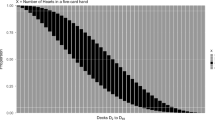Abstract
Many studies that involve people's perceptions or behaviors focus on aggregate rather than individual responses. For example, variables describing public perceptions for some set of events may be represented as mean scores for each event. Event mean scores then become the unit of analysis for each variable. The variance of these mean scores for a variable is not only a function of the variation among the events themselves, but is also due to the variation among respondents and their possible responses. This is also the case for the covariances between variables based on event mean scores. In many contexts the variance and covariance components attributable to the sampling of respondents and their responses may be large; these components can be described as measurement error. In this paper we show how to estimate variances and covariances of aggregate variables that are free of these sources of measurement error. We also present a measure of reliability for the event means and examine the effect of the number of respondents on these spurious components.
To illustrate how these estimates are computed, forty-two respondents were asked to rate forty events on seven risk perception variables. Computing the variances and covariances for these variables based on event means resulted in relatively large components attributable to measurement error. A demonstration is given of how this error is removed and the resulting effect on our estimates.
Similar content being viewed by others
References
Bollen, Kenneth A. (1989). Structural Equations with Latent Variables, New York: Wiley.
Burns, William J. (1990). Introducing structural models and influence diagrams into risk perception research: their value for theory construction and decision making, Ph.D. dissertation, Department of Decision Sciences, University of Oregon.
Cronbach, Lee J., Gleser, Goldine C., Nanda, Harinder, and Rajaratnam, Nageswari (1972). The Dependability of Behavioral Measurement: Theory of Generalizability for Score Profiles, New York: Wiley.
Hartley, H. O., Rao, J. N. K., and LaMotte, Lynn (1978). A simple synthesis-based method of variance component estimation, Biometics 34, 233–242.
Hogg, Robert V. and Craig, Allen T. (1978). Introduction to Mathematical Statistics. New York: MacMillan.
Lord, Frederic M. and Novick, Melvin R. (1968). Statistical Theories of Mental Test Scores, Reading, Massachusetts: Addison-Wesley.
Olkin, I. and Pratt, V. W. (1958). Unbiased estimation of certain correlation coefficients, Annals of Mathematical Statistics 29, 201–211.
Scheffe, Henry (1959). The Analysis of Variance, New York: Wiley.
Searle, Shayle R. (1987). Linear Models for Unbalanced Data, New York: Wiley.
Seigel, P. M. (1971). Prestige in the American occupational structure. Unpublished dissertation. University of Chicago.
Shavelson, Richard J. and Webb, Noreen M. (1981). Generalizability theory: 1973–80, British Journal of Mathematical and Statistical Psychology 34, 133–166.
Slovic, P., Fischoff, B., and Lichtenstein, S. (1985). In Perilous Progress: Managing the Hazards of Technology, edited by R., Kates, C., Hohenemser, and J., Kasperson, Boulder: Westview Press.
Spearman, C. (1910). Correlation calculated from faulty data, British Journal of Psychology 34, 271–295.
Warr, M. (1989). What is the perceived seriousness of crimes?, Criminology 27, 795–821.
Author information
Authors and Affiliations
Additional information
The data used in this paper were collected at the University of Oregon as part of a grant from the National Science Foundation (SES-8912104).
Rights and permissions
About this article
Cite this article
O'Brien, R.M., Burns, W.J. & Slovic, P. The effects of sampling on measures of association between variables based on sample means. Qual Quant 26, 409–425 (1992). https://doi.org/10.1007/BF00170452
Issue Date:
DOI: https://doi.org/10.1007/BF00170452




